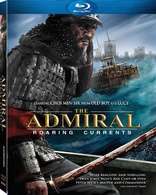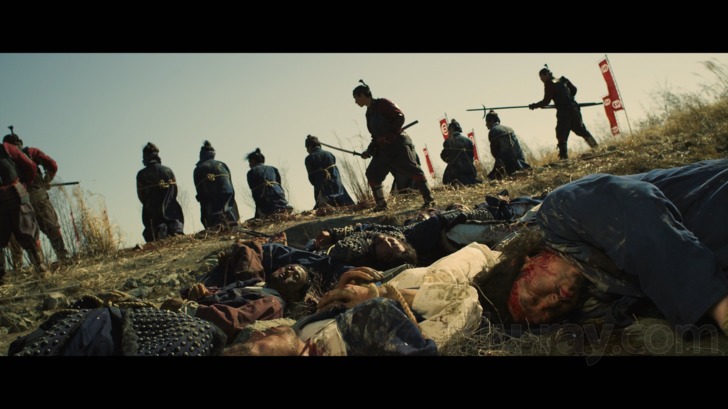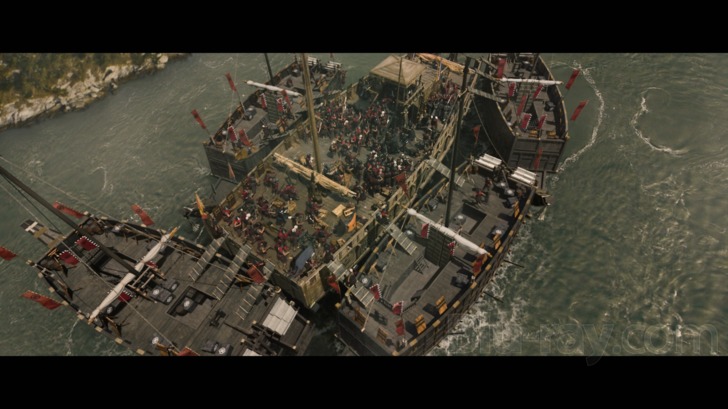The Admiral: Roaring Currents Blu-ray Movie
HomeThe Admiral: Roaring Currents Blu-ray Movie 
Myeong-ryangCJ Entertainment | 2014 | 129 min | Not rated | Apr 28, 2015

Movie rating
7.1 | / 10 |
Blu-ray rating
| Users | 4.8 | |
| Reviewer | 4.0 | |
| Overall | 4.2 |
Overview
The Admiral: Roaring Currents (2014)
During the Japanese invasion of Korea, which lasted from 1592 through 1598, the legendary Joseon Admiral Yi Sun-Shin won the naval Battle of Myeongryang against impossible odds. With only 12 ships remaining in his fleet, he vanquished a superior force of over 200 Japanese warships. The battle, which took place in 1597 in the Myeongryang Strait off the southwest coast of the Korean Peninsula, is an iconic event in Korean history.
Starring: Choi Min-sik, Kim Myung-gon, Ryu Seung-ryong, Cho Jin-woong, Jin GooDirector: Kim Han-min
| Foreign | Uncertain |
| History | Uncertain |
| War | Uncertain |
Specifications
Video
Video codec: MPEG-4 AVC
Video resolution: 1080p
Aspect ratio: 2.40:1
Original aspect ratio: 2.39:1
Audio
Korean: DTS-HD Master Audio 5.1 (48kHz, 24-bit)
Korean: LPCM 2.0
English: DTS-HD Master Audio 5.1 (48kHz, 24-bit)
English: LPCM 2.0 (48kHz, 24-bit)
Subtitles
English
Discs
50GB Blu-ray Disc
Single disc (1 BD)
Packaging
Slipcover in original pressing
Playback
Region A (locked)
Review
Rating summary
| Movie | 4.0 | |
| Video | 4.5 | |
| Audio | 5.0 | |
| Extras | 1.5 | |
| Overall | 4.0 |
The Admiral: Roaring Currents Blu-ray Movie Review
Charging a Navy While All the World Wonder'd
Reviewed by Michael Reuben May 1, 2015The Admiral: Roaring Currents is the first Korean film to attempt a depiction of the Battle of Myeongnyang, one of the pivotal events in Korean history. It may be presumptuous to draw an analogy to American history, but imagine if Hollywood had waited until now to make a movie about D-Day or the Civil War. By comparison to the events depicted in The Admiral, however, these are recent occurrences. The Battle of Myeongnyang took place in 1597, during the reign of the Joseon dynasty. Under the command of Admiral Yi Sun-Shin, a legendary figure in Korean history, a tiny fleet of only twelve vessels (some say thirteen) beat back an invading Japanese armada of over 300 ships. Had Admiral Yi lost the battle, the map of the Far East would likely look very different today. Korea has had a thriving film industry for many years now, but only recently has the local special effects capability expanded to the extent necessary to handle a project of The Admiral's scale. In 2008, China's production of John Woo's Red Cliff provided an example of the successful melding of Hollywood techniques with indigenous stories and traditions. With adequate technical resources now available in his own country, director and co-writer Kim Han-min (War of the Arrows) applied a similar approach to portraying Admiral Yi's incredible (many said impossible) victory against the Japanese navy. Released in Korea in July 2014, the film broke box office records and is currently the top-grossing film in Korea's history.

The Admiral falls roughly into two halves. The first establishes the background and builds up to the historic Battle of Myeongnyang, while the second depicts the epic clash itself. The first half is likely to be tough going for most Western viewers, simply because the story is unfamiliar, whereas Korean audiences already know this history (or so I have read). Director Kim and his co-writer, Jeon Cheol-hong, have a large and complex stage to set. Japan and the Joseon dynasty had warred for nearly five years preceding the Battle, with significant casualties and shifts in power on both sides. A few screens of opening text that summarize Admiral Yi's (Choi Min-sik) fall from grace during the war's early years provide a hint of the complexity. Accused by a double agent (according to the translation), the Admiral was stripped of rank and tortured. But after the Joseon navy suffers a crushing defeat and is nearly wiped out at the Battle of Chilcheollyang, the emperor hurriedly reinstates his finest naval strategist, despite his weakened health. (According to some quick historical research, Admiral Yi's demotion actually resulted from multiple causes, but films are rarely a good format for conveying historical nuance.) As the Admiral sits at the head of a table being briefed by squabbling and demoralized junior officers, he appears to be both present and elsewhere. As will so often be the case in the coming days, his officers look at him without fully grasping Yi's sense of duty. He knows that he has been given a situation that is unsalvageable, and he fully expects to die in the coming fight, but he is calculating how much damage he can inflict on the enemy while doing so. To accomplish that task, he must transform the fear and defeat he sees on the faces all around him into courage, a goal he explains to his son (Kim Tae-Hun) in a rare private moment. On the Japanese side, political maneuvering is creating fault lines that, at key moments in the Battle, will weaken the attacking forces. The Japanese chancellor has dispatched Kurushima, known as "the Pirate King" (Ryu Seung-Ryong), to lead the assault, to the dismay of Commander Todo (Kim Myung-gon), who regards Kurushima as little more than a savage. The chancellor's decision is motivated by the news of Admiral Yi's reinstatement. In previous battles, Yi defeated Todo, whereas Kurushima's name inspires fear. Despite their internal differences, the Japanese forces remain confident, and why not? All told, they have 330 ships against Yi's twelve. Admiral Yi's preparations are plagued with obstacles and setbacks. He is betrayed and deserted by one of his officers. He narrowly escapes assassination, and sabotage claims his most heavily armored ship (the so-called "turtle" ship). He is confronted on all sides by doubt and a sense of impending doom. But a turning point arrives as the Admiral stares into the rushing waters of the Myeongnyang Strait. Whether this is how the real Admiral Yi first conceived of using the Strait's treacherous currents against his enemy is irrelevant. In cinematic terms, the moment of inspiration has been captured. In The Admiral's second half, director Kim orchestrates a brutal and bloody naval battle with every resource that a filmmaker now has to recreate the past. Cannons fire, flaming arrows fly, guns blaze, ships rotate to port and starboard as the rowers heave, the wounded and the dead plunge into the water, staining it with their blood. Consistent with the historical accounts, Admiral Yi takes his flagship out ahead to face Kurushima's massive fleet alone, so that he can lure the over-confident Pirate King into the whirlpool of currents that will ultimately destroy dozens of Japanese ships. He takes huge risks, letting the flagship be encircled by four enemy vessels before attempting to break away, then using his flagship as a battering ram to charge the enemy fleet. Repeatedly risking his own life, and expecting to die each time, the Admiral miraculously survives. It is the grandness of these gestures that ultimately converts fear into courage, as the commanders and crews of the remaining Korean ships find themselves inspired by Admiral Yi's example. Even the local villagers watching from the shore join the war effort, piling into fishing boats and lending assistance. Against all odds, Admiral Yi not only wins the battle, but also lives to be celebrated for his victory. (This is history, not a spoiler.) Director Kim wisely does not attempt to trace the war's further course but concludes the film in a quiet moment between the Admiral and his son, who asks his father what gave him the idea to use the currents strategically. The Admiral's answer is suitably cryptic. Who knows where inspiration comes from?
The Admiral: Roaring Currents Blu-ray Movie, Video Quality 

The Admiral: Roaring Currents was shot on Red by cinematographer Kim Tae-seong, who shot War of the Arrows for director Kim and also composed the score for both films. Post-production was completed on a digital intermediate, from which CJ International's 1080p, AVC-encoded Blu-ray was presumably sourced. Contemporary audiences are too sophisticated to be completely fooled by computer-generated shots of giant fleets of antique ships, but that's no fault of the Blu-ray image, which is clean, sharp, detailed, colorful and presents the extensive CG work as well as one can possibly hope. Practical effects such as cannons, guns, swords, and the elaborate and extensive period costumes are reproduced with truly impressive fine detail—a real benefit for the Japanese battle uniforms, which were custom designed for each major warlord and commander. (Korean armor, by contrast, was standardized.) The blacks of nighttime vigils and the contrast that reveals shadow detail by firelight are both properly set. There is some light, occasional banding at scene transitions, but otherwise the image appeared to be flawless. CJ International has mastered The Admiral with an average bitrate of 23.94 Mbps, and the compressionist appears to have allocated the available bits carefully so that the latter half of the film, which is far more action-packed, gets the larger share that it requires for a smooth presentation.
The Admiral: Roaring Currents Blu-ray Movie, Audio Quality 

Both English and subtitled Korean soundtracks are provided, each in a choice of lossless PCM 2.0 and DTS-HD MA 5.1. The 5.1 track is the clear winner, because the sound mix for The Admiral is superb, especially in the second half when the naval battle begins. With an almost constant assault of surging ocean, creaking (and breaking) hulls, cannon and gunfire, clashing swords, exploding shells, bullets hitting hulls, arrows flying through the air, men barking orders (or simply screaming) and dozens of other sounds layered into the mix, The Admiral's soundtrack plunges the viewer into the middle of battle to the death fought with weapons that are antique but deadly nevertheless. The bass extension reaches down to the low registers, and even when the weapons aren't thundering, the drums in Kim Tae-seong's musical score are doing so. (Kim seems to have worked into the score the drumbeats used to keep the rowers working in unison.) At a few key moments, most of the sound drops out entirely, giving the effect of a moment suspended in time that allows both the audience and Admiral Yi to take in what is happening. Having watched the film with subtitles and the Korean dialogue, I cannot vouch for the clarity of the dialogue, but once The Admiral gets past its initial historical exposition, it is far more a visual and aural experience than one driven by dialogue.
The Admiral: Roaring Currents Blu-ray Movie, Special Features and Extras 

- Making Of (1080i; 2.40:1; 4:58): Though brief, this behind-the-scenes featurette gives some idea of the challenges involved in making The Admiral, with glimpses of the green screen sets and the elaborate machinery used to create the illusion of a ship's deck pitching and tumbling on a turbulent sea. The director, stars and cinematographer appear in brief interviews. In Korean with English subtitles.
- Highlights (480i; 2.40:1; 30:09): As the title suggests, this is nothing more than a selection of clips from The Admiral (windowboxed in standard definition). The clips appear to have been chosen to highlight the key players and their roles, because character names have been added as additional titles. In Korean and Japanese with English and Korean subtitles.
- The Admiral (Teaser) (1080p; 2.40:1; 0:53): In Korean with English subtitles.
- The Admiral (Trailer) (1080p; 2.40:1; 1:23): In Korean with English subtitles.
- Trailers (1080p): Some are in English, while others are in Korean with English subtitles.
The Admiral: Roaring Currents Blu-ray Movie, Overall Score and Recommendation 

When The Admiral played briefly in U.S. theaters last year, some reviewers found it almost jingoistic in its portrayal of the Korean side as universally courageous and self-sacrificing. But what else would you expect from an account of one of the country's proudest moments, when its forces won an impossible victory against seemingly impossible odds? It's hard to envision such a victory without imagining that every single person who contributed to it found hidden reserves of courage in him- or herself, which is precisely what Admiral Yi (in Choi Min-sik's portrayal) hoped to inspire. As the events of the film's first hour make clear, the Korean forces did not begin bravely. They became brave under the Admiral's leadership, which is why he is revered. To bring such high drama to the screen with so much spectacle is no small achievement. Highly recommended.
Similar titles
Similar titles you might also like

War of the Arrows
Choi-jong-byeong-gi Hwal
2011

The Front Line
고지전 / Go-ji-jeon
2011

Operation Red Sea
红海行动 / Hong hai xing dong
2018

White Vengeance
鴻門宴
2011

The Eight Hundred
八佰 / Ba bai
2020

Land of Mine
Under Sandet
2015

Assassination
2015

My Way
마이웨이 / Mai Wei
2011

Kundo
2014

Wife of a Spy
スパイの妻
2020

Omar
2013

9th Company
9 rota | Collector's Edition
2005

The Captain
Der Hauptmann
2017

Furie
Hai Phuong
2019

The 12th Man
Den 12. mann
2017

Battle for Incheon: Operation Chromite
Operation Chromite / In-cheon sang-ryuk jak-jeon
2016

City of Life and Death
南京!南京! / Nanjing! Nanjing!
2009

Assembly
Jí Jié Hào
2007

The Battle of Jangsari
장사리: 잊혀진 영웅들
2019

Fires on the Plain 4K
野火 / Nobi
1959